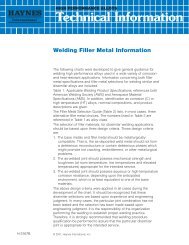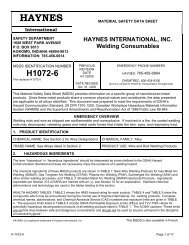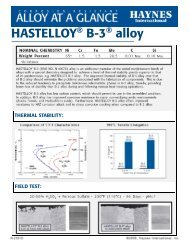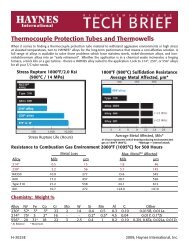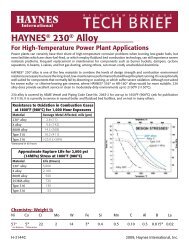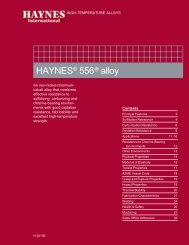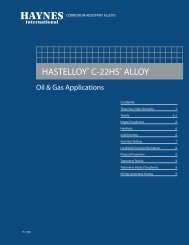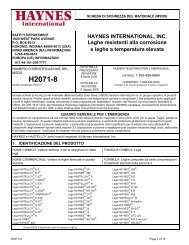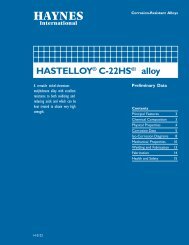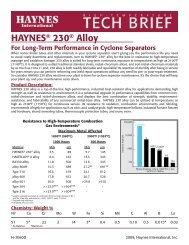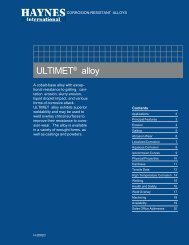H-3057D 25 alloy - Haynes International, Inc.
H-3057D 25 alloy - Haynes International, Inc.
H-3057D 25 alloy - Haynes International, Inc.
- No tags were found...
Create successful ePaper yourself
Turn your PDF publications into a flip-book with our unique Google optimized e-Paper software.
HIGH-TEMPERATURE ALLOYSHAYNES ® <strong>25</strong> <strong>alloy</strong>A Co-Ni-Cr-W <strong>alloy</strong> thatcombines excellent hightemperaturestrength withgood oxidation resistance.ContentsChemical Compositionand Principal Features 3Creep and Stress-Rupture Strength 4Typical Tensile Properties 6Cold-Worked Properties 7Impact Strength 9Thermal Stability 9Typical Physical Properties 10Metal-to-MetalGalling Resistance 12Hot Hardness Properties 12Aqueous Corrosion Resistance 12Oxidation Resistance 13Sulfidation Resistance 14Fabrication Characteristics 15Welding 17Health and SafetyInformation 17Machining 18H-<strong>3057D</strong>HAYNES ® <strong>25</strong> <strong>alloy</strong>
HAYNES ® <strong>25</strong> <strong>alloy</strong>©2004 <strong>Haynes</strong> <strong>International</strong>, <strong>Inc</strong>.
PRINCIPAL FEATURESExcellent High-TemperatureStrength and GoodOxidation ResistanceHAYNES ® <strong>25</strong> <strong>alloy</strong> is a cobaltnickel-chromium-tungsten<strong>alloy</strong> that combines excellenthigh-temperature strength withgood resistance to oxidizingenvironments up to 1800°F(980°C) for prolonged exposures,and excellent resistanceto sulfidation. It can befabricated and formed byconventional techniques, andhas been used for cast components.Other attractivefeatures include excellentresistance to metal galling.FabricationHAYNES <strong>25</strong> <strong>alloy</strong> has goodforming and welding characteristics.It may be forged orotherwise hot-worked, providingthat it is held at 2200°F(1205°C) for a time sufficientto bring the entire piece totemperature. The <strong>alloy</strong> hasgood ductility, and thus alsomay be formed by cold working.The <strong>alloy</strong> does workhardenvery rapidly, however,so frequent intermediateannealing treatments will beneeded for complex componentforming operations. All hot- orcold-worked parts should beannealed and rapidly cooled inorder to restore the best balanceof properties. The <strong>alloy</strong>can be welded by both manualand automatic welding methods,including gas tungsten arc(GTAW), gas metal arc(GMAW), shielded metal arc,electron beam and resistancewelding. It exhibits goodrestraint welding characteristics.Heat TreatmentWrought HAYNES <strong>25</strong> <strong>alloy</strong> isfurnished in the solution heattreatedcondition, unlessotherwise specified. The <strong>alloy</strong>is normally solution heat-treatedat 2150 to 2<strong>25</strong>0°F (1175 to1230°C) and rapidly cooled orwater-quenched for optimalproperties. Annealing attemperatures less than thesolution heat-treating temperaturewill produce some carbideprecipitation in <strong>25</strong> <strong>alloy</strong>, whichmay affect the <strong>alloy</strong>’s properties.Available in Convenient FormsHAYNES <strong>25</strong> <strong>alloy</strong> is producedin the form of plate, sheet,strip, billet, bar, wire, coatedelectrodes, pipe and tubing.ApplicationsHAYNES <strong>25</strong> <strong>alloy</strong> combinesproperties which make itsuitable for a number ofcomponent applications in theaerospace industry, includingparts in established militaryand commercial gas turbineengines. In modern engines, ithas largely been replaced bynewer materials such asHAYNES 188 <strong>alloy</strong>, and, mostrecently, 230 ® <strong>alloy</strong>, whichpossess improved properties.Another area of significantusage for <strong>25</strong> <strong>alloy</strong> is as abearing material, for both ballsand races.Applicable SpecificationsHAYNES <strong>25</strong> <strong>alloy</strong> is coveredby the following specifications:AMS 5537 (sheet, strip andplate), AMS 5759 (bar, ringsand forgings), AMS 5796(welding wire), and AMS 5797(coated welding electrodes).The UNS number for thismaterial is R30605.Nominal Chemical Composition, Weight PercentCo a Ni Cr W Fe Mn Si C51 10 20 15 3* 1.5 0.4* 0.10a*MaximumAs balance3HAYNES ® <strong>25</strong> <strong>alloy</strong>
TYPICAL TENSILE PROPERTIESCold-Rolled and 2200°F (1205°C) Solution-Annealed Sheet*UltimateTest Tensile 0.2% Yield ElongationTemperature Strength Strength in 2 in. (51 mm)°F °C Ksi MPa Ksi MPa %Room Room 146 1005 69 475 511000 540 112 770 48 330 601200 650 108 745 48 330 601400 760 93 640 41 285 421600 870 60 415 36 <strong>25</strong>0 451800 980 34 235 18 1<strong>25</strong> 362000 1095 23 160 11 76 48*Limited dataHot-Rolled and 2<strong>25</strong>0°F (1230°C) Solution-Annealed Bar*UltimateTest Tensile 0.2% Yield ElongationTemperature Strength Strength in 2 in. (51 mm)°F °C Ksi MPa Ksi MPa %Room Room 147 1015 73 505 601000 540 113 780 43 295 631200 650 105 7<strong>25</strong> 43 295 491400 760 90 620 41 285 291600 870 54 370 34 235 291800 980 28 195 19 130 41*Limited dataVacuum Investment Castings — Solution Treated*UltimateTest Tensile 0.2% Yield Elongation ReductionTemperature Strength Strength in 5D in Area°F °C Ksi MPa Ksi MPa % %Room Room 98 675 60 415 <strong>25</strong> 33800 4<strong>25</strong> 81 560 30 205 42 351200 650 74 510 27 185 30 341400 760 46 315 <strong>25</strong> 170 24 291600 870 43 295 24 165 <strong>25</strong> 311800 980 28 195 23 160 24 34*Limited dataHAYNES ® <strong>25</strong> <strong>alloy</strong> 6
COLD-WORKED PROPERTIESHAYNES <strong>25</strong> <strong>alloy</strong> has excellent strength and hardness characteristics in the cold-worked condition.These high property levels are also evident at elevated temperature, making <strong>25</strong> <strong>alloy</strong> quite suitable forapplications such as ball bearings and bearing races. A modest additional increase in hardness andstrength can be achieved through aging of the cold-worked material.Typical Tensile Properties, Cold-Worked Sheet*UltimateElongationCold Test Tensile 0.2% Yield inReduction Temperature Strength Strength 2 in. (51 mm)°F °C Ksi MPa Ksi MPa %70 20 155 1070 105 7<strong>25</strong> 411000 540 114 785 78 540 4810 1200 650 115 795 80 550 371400 760 87 600 67 460 81600 870 62 4<strong>25</strong> 47 3<strong>25</strong> 131800 980 39 270 27 185 1570 20 166 1145 124 855 301000 540 134 9<strong>25</strong> 107 740 2915 1200 650 129 890 111 765 151400 760 104 715 86 595 51600 870 70 485 52 360 91800 980 40 275 30 205 570 20 183 1260 141 970 191000 540 156 1075 133 915 1820 1200 650 137 945 120 8<strong>25</strong> 21400 760 107 740 96 660 31800 980 41 285 30 205 4*Limited data for cold-rolled 0.050-inch (1.3 mm) thick sheet7HAYNES ® <strong>25</strong> <strong>alloy</strong>
COLD-WORKED PROPERTIESTypical Tensile Properties, Cold-Worked and Aged Sheet*UltimateElongationTest Tensile 0.2% Yield inTemperature Strength Strength 2 in. (51 mm)Condition °F °C Ksi MPa Ksi MPa %15% CW 70 20 168 1160 136 940 31+ Age A 1200 650 128 885 104 715 2370 20 181 1<strong>25</strong>0 152 1050 171000 540 151 1040 129 890 1920% CW 1200 650 144 995 128 885 8+ Age A 1400 760 108 745 97 670 21600 870 74 510 59 405 61800 980 43 295 33 230 570 20 191 1315 162 1115 16600 315 165 1140 132 910 2820% CW 1000 540 149 10<strong>25</strong> 124 855 23+ Age B 1200 650 140 965 119 820 131400 760 116 800 92 635 71600 870 71 490 50 345 91800 980 42 290 31 215 12*Limited data for cold-rolled 0.050-inch (1.3 mm) thick sheet.Age A = 700°F (370°C)/1 hourAge B = 1100°F (595°C)/2 hoursTypical Hardness at 70°F (20°C), Cold-Worked and Aged Sheet*Hardness, Rockwell C, After Indicated Level ofCold Work and Subsequent Aging TreatmentCold-Work 900°F (480°C) 1100°F (595°C)% None 5 Hours 5 HoursNone 24 <strong>25</strong> <strong>25</strong>5 31 33 3110 37 39 3915 40 44 4320 44 44 47*Limited data for cold-rolled 0.070-inch (1.8 mm) thick sheet.HAYNES ® <strong>25</strong> <strong>alloy</strong>8
IMPACT STRENGTH PROPERTIES, PLATETypical Charpy V-NotchTestImpact ResistanceTemperature°F (°C) Ft.-lbs. Joules-321 (-196) 109 148-216 (-138) 134 182-108 ( -78) 156 212-20 ( -29) 179 243Room 193 26<strong>25</strong>00 (260) 219 2971000 (540) 201 2731200 (650) 170 2301400 (760) 143 1941600 (870) 120 1631800 (980) 106 144THERMAL STABILITYWhen exposed for prolonged periods at intermediate temperatures, HAYNES <strong>25</strong> <strong>alloy</strong> exhibits a loss ofroom temperature ductility in much the same fashion as some other solid-solution-strengthened super<strong>alloy</strong>s,such as HASTELLOY ® X <strong>alloy</strong> or <strong>alloy</strong> 6<strong>25</strong>. This behavior occurs as a consequence of theprecipitation of deleterious phases. In the case of a <strong>25</strong> <strong>alloy</strong>, the phase in question is Co 2W lavesphase. HAYNES 188 <strong>alloy</strong> is significantly better in this regard than <strong>25</strong> <strong>alloy</strong>; however, for applicationswhere thermal stability is important, 230 ® <strong>alloy</strong> is an even better selection.Room-Temperature Properties of Sheet After Thermal Exposure*UltimateExposure Tensile 0.2% Yield ElongationTemperature Strength Strength°F (°C) Hours Ksi MPa Ksi MPa %None 0 135.0 930 66.8 460 48.71200 (650) 500 123.6 850 70.3 485 39.21000 140.0 965 92.3 635 24.8<strong>25</strong>00 130.7 900 95.1 655 12.01400 (760) 100 115.3 795 68.9 475 18.11600 (870) 100 113.6 785 72.1 495 9.1500 126.1 870 77.3 535 3.51000 142.0 980 81.7 565 5.0*Composite of multiple sheet lot tests.9HAYNES ® <strong>25</strong> <strong>alloy</strong>
TYPICAL PHYSICAL PROPERTIESTemp., °F British Units Temp., °C Metric UnitsDensity Room 0.330 lb/in 3 Room 9.13 g/cm 3Melting Range 24<strong>25</strong>-<strong>25</strong>70 1330-1410Electrical Room 34.9 µohm-in Room 88.6 µohm-cmResistivity 200 35.9 µohm-in 100 91.8 µohm-cm400 37.6 µohm-in 200 95.6 µohm-cm600 38.5 µohm-in 300 97.6 µohm-cm800 39.1 µohm-in 400 98.5 µohm-cm1000 40.4 µohm-in 500 100.8 µohm-cm1200 41.8 µohm-in 600 104.3 µohm-cm1400 42.3 µohm-in 700 106.6 µohm-cm1600 40.6 µohm-in 800 107.8 µohm-cm1800 37.7 µohm-in 900 101.1 µohm-cm1000 95.0 µohm-cmThermal Conductivity Room 65 BTU-in/ft 2 hr-°F Room 9.4 W/m-K200 75 BTU-in/ft 2 hr-°F 100 10.9 W/m-K400 90 BTU-in/ft 2 hr-°F 200 12.9 W/m-K600 105 BTU-in/ft 2 hr-°F 300 14.8 W/m-K800 120 BTU-in/ft 2 hr-°F 400 16.8 W/m-K1000 135 BTU-in/ft 2 hr-°F 500 18.7 W/m-K1200 150 BTU-in/ft 2 hr-°F 600 20.7 W/m-K1400 165 BTU-in/ft 2 hr-°F 700 22.6 W/m-K1600 182 BTU-in/ft 2 hr-°F 800 24.7 W/m-K1800 200 BTU-in/ft 2 hr-°F 900 26.9 W/m-K1000 29.2 W/m-KHAYNES ® <strong>25</strong> <strong>alloy</strong>10
TYPICAL PHYSICAL PROPERTIES (continued)Temp., °F British Units Temp., °C Metric UnitsMean Coefficient of 70-200 6.8 microinches/in-°F <strong>25</strong>-100 12.3 µm/m-°CThermal Expansion 70-400 7.2 microinches/in-°F <strong>25</strong>-200 12.9 µm/m-°C70-600 7.6 microinches/in-°F <strong>25</strong>-300 13.6 µm/m-°C70-800 7.8 microinches/in-°F <strong>25</strong>-400 14.0 µm/m-°C70-1000 8.0 microinches/in-°F <strong>25</strong>-500 14.3 µm/m-°C70-1200 8.2 microinches/in-°F <strong>25</strong>-600 14.6 µm/m-°C70-1400 8.6 microinches/in-°F <strong>25</strong>-700 15.1 µm/m-°C70-1600 9.1 microinches/in-°F <strong>25</strong>-800 15.8 µm/m-°C70-1800 9.4 microinches/in-°F <strong>25</strong>-900 16.5 µm/m-°C70-2000 9.8 microinches/in-°F <strong>25</strong>-1000 17.0 µm/m-°C<strong>25</strong>-1100 17.6 µm/m-°CDYNAMIC MODULUS OF ELASTICITYDynamicDynamicModulus ofModulus ofElasticity,Elasticity,Temp, °F 10 6 psi Temp.,°C GPaRoom 32.6 Room 2<strong>25</strong>200 32.3 100 222400 31.0 200 214600 29.4 300 204800 28.3 400 1971000 26.9 500 1881200 <strong>25</strong>.8 600 1811400 24.3 700 1741600 22.8 800 1631800 21.4 900 1541000 14611HAYNES ® <strong>25</strong> <strong>alloy</strong>
METAL-TO-METAL GALLING RESISTANCEHAYNES <strong>25</strong> <strong>alloy</strong> exhibits excellent resistance to metal galling. Wear results shown below were generatedfor standard matching material room-temperature pin on disc tests. Wear depths are given as afunction of applied load. The results indicate that <strong>25</strong> <strong>alloy</strong> is superior in galling resistance to manymaterials, and is surpassed only by ULTIMET ® <strong>alloy</strong> and HAYNES 6B <strong>alloy</strong>. Both of these materialswere specifically designed to have excellent wear resistance.Room-Temperature Wear Depth For Various Applied Loads3,000 lbs. (1,365 Kg) 6,000 lbs. (2,7<strong>25</strong> Kg) 9,000 lbs. (4,090 Kg)Material mils µm mils µm mils µm6B <strong>alloy</strong> 0.02 0.6 0.03 0.7 0.02 0.5ULTIMET <strong>alloy</strong> 0.11 2.9 0.11 2.7 0.08 2.0<strong>25</strong> <strong>alloy</strong> 0.23 5.9 0.17 4.2 0.17 4.2188 <strong>alloy</strong> 1.54 39.2 3.83 97.3 3.65 92.6HR-160 ® <strong>alloy</strong> 1.73 43.9 4.33 109.9 3.81 96.8214 <strong>alloy</strong> 2.32 59.0 3.96 100.5 5.55 141.0556 <strong>alloy</strong> 3.72 94.4 5.02 127.6 5.48 139.3230 ® <strong>alloy</strong> 4.44 112.7 7.71 195.8 8.48 215.5HR-120 <strong>alloy</strong> 6.15 156.2 7.05 179.0 10.01 <strong>25</strong>4.2HIGH-TEMPERATURE HARDNESS PROPERTIESThe following are results from standard vacuum furnace hot hardness tests. Values are given in originallymeasured DPH (Vickers) units and conversions to Rockwell C/B scale in parentheses.Vickers Diamond Pyramid Hardness (Rockwell C/B Hardness)70°F (20°C) 800°F (4<strong>25</strong>°C) 1000°F (540°C) 1200°F (650°C) 1400°F (760°C)Solution Treated <strong>25</strong>1 (R C22) 171 (R B87) 160 (R B83) 150 (R B80) 134 (R B74)15% Cold Work 348 (R C35) <strong>25</strong>4 (R C23) 234 (R B97) 218 (R B95) -20% Cold Work 401 (R C41) 318 (R C32) 284 (R C27) 268 (R C<strong>25</strong>) -<strong>25</strong>% Cold Work 482 (R C48) 318 (R C32) 300 (R C30) 286 (R C28) -AQUEOUS CORROSION RESISTANCEHAYNES <strong>25</strong> <strong>alloy</strong> was not designed for resistance to corrosive aqueous media. Representative averagecorrosion data are given for comparison. For applications requiring corrosion resistance in aqueousenvironments, ULTIMET <strong>alloy</strong> and HASTELLOY ® corrosion-resistant <strong>alloy</strong>s should be considered.Average Corrosion Rate, mils per year (mm per year)1% HCl (Boiling) 10% H 2SO 4(Boiling) 65% HNO 3(Boiling)ULTIMET <strong>alloy</strong>
OXIDATION RESISTANCEHAYNES ® <strong>25</strong> <strong>alloy</strong> exhibits good resistance to both air and combustion gas oxidizing environments, andcan be used for long-term continuous exposure at temperatures up to 1800°F (980°C). For exposures ofshort duration, <strong>25</strong> <strong>alloy</strong> can be used at higher temperatures. Applications for which oxidation resistanceis a serious consideration normally call for newer, more capable materials such as 230 ® <strong>alloy</strong> orHAYNES 188 <strong>alloy</strong>. This is particularly important at temperatures above 1800°F (980°C).Comparative Burner Rig Oxidation Resistance1000 Hour Exposure at 1800°F (980°C)Metal Average MaximumLoss Metal Affected Metal AffectedMaterial Mils µm Mils µm Mils µm230 <strong>alloy</strong> 0.8 20 2.8 71 3.5 89HAYNES 188 <strong>alloy</strong> 1.1 28 3.5 89 4.2 107HASTELLOY ® X <strong>alloy</strong> 2.7 69 5.6 142 6.4 153Alloy 6<strong>25</strong> 4.9 124 7.1 180 7.6 193<strong>25</strong> <strong>alloy</strong> 6.2 157 8.3 211 8.7 221Alloy 617 2.7 69 9.8 249 10.7 272Alloy 800H 12.3 312 14.5 368 15.3 389Type 310 Stainless Steel 13.7 348 16.2 411 16.5 419Alloy 600 12.3 312 14.4 366 17.8 452Oxidation Test ParametersBurner rig oxidation tests wereconducted by exposingsamples 3/8 in. x 2.5 in. xthickness (9 mm x 64 mm xthickness), in a rotating holder,to products of combustion ofNo. 2 fuel oil burned at a ratio ofair to fuel of about 50:1. (Gasvelocity was about 0.3 mach).Samples were automaticallyremoved from the gas streamevery 30 minutes and fancooledto near ambient temperatureand then reinsertedinto the flame tunnel.Comparative Oxidation Resistance in Flowing Air*Average Metal Affected in 1008 Hours**1800°F (980°C) 2000°F (1095°C) 2100°F (1150°C)Material Mils µm Mils µm Mils µmHAYNES 188 <strong>alloy</strong> 0.6 15 1.3 33 8.0 203230 <strong>alloy</strong> 0.7 18 1.3 33 3.4 86<strong>25</strong> <strong>alloy</strong> 0.7 18 10.2 <strong>25</strong>9 19.2 488Alloy 6<strong>25</strong> 0.7 18 4.8 122 18.2 462X <strong>alloy</strong> 0.9 23 2.7 69 5.8 147Alloy 617 1.3 33 1.8 46 3.4 86* Flowing air at a velocity of 7.0 ft./min. (213.4 cm/min.) past the samples. Samples cycled to room temperature once-a-week.** Metal Loss + Average Internal Penetration.13HAYNES ® <strong>25</strong> <strong>alloy</strong>
OXIDATION RESISTANCEComparative Burner Rig Oxidation Resistance at 2000°F (1095°C) for 500 HoursOXIDATION DAMAGE, µm0 100 200 300 400 500 600 700 800 900230 <strong>alloy</strong>MetalLossMaximumInternalPenetration188 <strong>alloy</strong>X <strong>alloy</strong><strong>25</strong> <strong>alloy</strong>(><strong>25</strong> mils in 165 hours)0 5 10 15 20 <strong>25</strong> 30 35OXIDATION DAMAGE, MILSSULFIDATION RESISTANCE AT 1400°F (760°C)HAYNES ® <strong>25</strong> <strong>alloy</strong> has verygood resistance to gaseoussulfidation environmentsencountered in various industrialapplications. Tests wereconducted at 1400°F (760°C)in a gas mixture consisting of5 percent H 2, 5 percent CO,1 percent CO 2, 0.15 percentH 2S and 0.1 percent H 2O,balance Ar. Coupons wereexposed for 215 hours. This isa severe test, with equilibriumsulfur partial pressure of 10 -6 to10 -7 and oxygen partial pressuresless than that needed toproduce protective chromiumoxide scales.Average Metal Affected (Mils)161412108642215 hours @ 1400°F (760°C)Ar-5% H 2-5% CO-1% CO 2-0.15% H 2S-0.1% H 20>29 Mils400300200100Average Metal Affected (µm)0® HR-160 <strong>25</strong> 188 556 310 617 800H 6<strong>25</strong> X0HAYNES ® <strong>25</strong> <strong>alloy</strong>14
Schematic Representation of Metallographic TechniqueUsed for Evaluating Environmental Tests➤➤➤➤DC➤➤A➤B➤1. Metal Loss = (A - B)/22. Average Internal Penetration = C3. Maximum Internal Penetration = D4. Average Metal Affected = (A - B)/2) + C5. Maximum Metal Affected = ((A = B)/2) + DFABRICATION CHARACTERISTICSHeat TreatmentHAYNES ® <strong>25</strong> <strong>alloy</strong> is normalyfinal solution heat-treated at2150 to 2<strong>25</strong>0°F (1175 to1230°C) for a time commensuratedwith sectionthickness. Annealing duringfabrication can be performed ateven lower temperatures, but afinal, subsequent solution heattreatment is needed to produceoptimum properties andstructure. Please call <strong>Haynes</strong><strong>International</strong> for further information.Effect of Cold Reduction Upon Room-Temperature Properties*Ultimate% Tensile 0.2% Yield ElongationCold Subsequent Strength Strength in 2 in. (51 mm)Reduction Anneal Ksi MPa Ksi MPa % Hardness0 144.0 995 68.4 470 58.5 R C2410 181.9 1<strong>25</strong>5 123.6 850 37.1 R C3615 None 178.2 1230 148.5 10<strong>25</strong> 27.7 R C4020 193.5 1335 150.9 1040 18.2 R C42<strong>25</strong> 232.5 1605 183.9 1270 14.6 R C4410 163.0 11<strong>25</strong> 97.9 675 39.3 R C3215 1950°F 167.1 1150 91.2 630 43.8 R C3020 (1065°C) 170.7 1175 96.5 665 40.8 R C32<strong>25</strong> for 5 min. 169.5 1170 88.9 615 44.3 R C3210 156.6 1080 74.0 510 53.4 R C2715 2050°F 161.2 1110 78.6 540 51.9 R C2820 (1120°C) 164.8 1135 82.0 565 47.6 R C31<strong>25</strong> for 5 min. 165.6 1140 82.9 570 48.0 R C3010 148.1 1020 66.9 460 62.6 R C2115 2150°F 156.1 1075 73.6 505 55.4 R C2620 (1175°C) 154.0 1060 72.1 495 59.3 R C26<strong>25</strong> for 5 min. 149.3 1030 68.5 470 61.7 R C<strong>25</strong>*Based upon cold reductions taken upon 0.110-inch (2.8 mm) thick sheet.Duplicate tests.15HAYNES ® <strong>25</strong> <strong>alloy</strong>
FABRICATION CHARACTERISTICSEffect of Cold Reduction and Annealing Upon Grain Size% ASTMCold Subsequent % Grain SizeReduction Anneal Recrystallization Range0 None N/A 3 1/2 - 4*10
WELDINGHAYNES ® <strong>25</strong> <strong>alloy</strong> is readilywelded by Gas Tungsten Arc(GTAW), Gas Metal Arc(GMAW), Shielded Metal Arc(coated electrodes), electronbeam welding and resistancewelding techniques. Its weldingcharacteristics are similar tothose for HAYNES 188 <strong>alloy</strong>.Submerged Arc welding is notrecommended as this processis characterized by high heatinput to the base metal andslow cooling of the weld.These factors can increaseweld restraint and promotecracking.Base Metal PreparationThe joint surface and adjacentarea should be thoroughlycleaned before welding. Allgrease, oil, crayon marks,sulfur compounds and otherforeign matter should be removed.Contact with copper orcopper-bearing materials in thejoint area should be avoided. Itis preferable, but not necessary,that the <strong>alloy</strong> be in the solutionannealedcondition whenwelded.Filler Metal SelectionMatching composition filler metalis recommended for joining <strong>25</strong><strong>alloy</strong>. For shielded metal arcwelding, HAYNES <strong>25</strong> <strong>alloy</strong>electrodes (AMS 5797) areavailable. For dissimilar metaljoining of <strong>25</strong> <strong>alloy</strong> to nickel-,cobalt- or iron-base materials, <strong>25</strong><strong>alloy</strong> itself, 230-W filler wire,556 ® <strong>alloy</strong>, HASTELLOY S <strong>alloy</strong>(AMS 5838) or HASTELLOY W<strong>alloy</strong> (AMS 5786, 5787)welding products are suggested,depending upon theparticular case.Preheating, InterpassTemperatures and Post-Weld Heat TreatmentPreheat is not usually requiredso long as base metal to bewelded is above 32°F (0°C).Interpass temperaturesgenerally should be low.Auxiliary cooling methods maybe used between weld passes,as needed, providing that suchmethods do not introducecontaminants. Post-weld heattreatment is not normallyrequired for <strong>25</strong> <strong>alloy</strong>. Forfurther information, pleasecontact <strong>Haynes</strong> <strong>International</strong>.HEALTH & SAFETY INFORMATIONWelding can be a safe occupation.Those in the weldingindustry, however, should beaware of the potential hazardsassociated with welding fumes,gases, radiation, electric shock,heat, eye injuries, burns, etc.Also, local, municipal, state,and federal regulations (suchas those issued by OSHA)relative to welding and cuttingprocesses should be considered.Nickel-, cobalt-, and iron-base<strong>alloy</strong> products may contain, invarying concentrations, thefollowing elemental constituents:aluminum, cobalt,chromium, copper, iron,manganese,molybdenum, nickel andtungsten. For specific concentrationsof these and otherelements present, refer to theMaterial Safety Data Sheets(MSDS) H3095 and H1072 forthe product.Inhalation of metal dust orfumes generated from welding,cutting, grinding, melting, ordross handling of these <strong>alloy</strong>smay cause adverse healtheffects such as reduced lungfunction, nasal and mucousmembrane irritation. Exposureto dust or fumes which may begenerated in working with these<strong>alloy</strong>s may also cause eyeirritation, skin rash and effectson other organ systems.The operation and maintenanceof welding and cuttingequipment should conform tothe provisions of AmericanNational Standard ANSI/AWSZ49.1, (Safely in Welding andCutting). Attention is especiallycalled to Section 7(Protection of Personnel) and8 (Health Protection andVentilation) of ANSI/AWSZ49.1. Mechanical ventilationis advisable and, under certainconditions such as a veryconfined space, is necessaryduring welding or cuttingoperations, or both, to preventpossible exposure to hazardousfumes, gases, or dust thatmay occur.17HAYNES ® <strong>25</strong> <strong>alloy</strong>
MACHININGOperation High Speed Steel Tools Carbide ToolsRoughing, with M-40 series, 1 M-2, M-33, T-4, T-8 and C-1 or C-2 grade square insert,sever inter- T-15. 45° SCEA, -5° Back Rake, -5°ruptions; 45° SCEA 2 ,-10° Back Rake, + 10° Side Side Rake, 1/16" nose radius,Turning or Rake, 1/16" nose radius 1/4" depth of cut max.Facing 1/4" depth of cut max., 0.012" feed 40 sfm, .012 feed max.max., 15 sfm cutting speedDry, oil, or water baseWater base coolant 3 coolant 6Normal roughing; Same tool grades Same tool gradesTurning or 45° SCEA, 0° Back Rake, + 10° Side Same tool geometryFacing Rake, 1/16" nose radius 1/4" depth of cut max., .0151/4" depth of cut max., .015 feed feed max., 40-60 sfmmax.depending on rigidity of20 sfm cutting speed setup.Water base coolantDry, 4,5 oil or water basecoolant 6Finishing; M-40 series, M-33, M-3, T-8 and T-15 C-2 or C-3 grade square insert,Turning or 15-45°SCEA, + 10° Back Rake, + if popssibleFacing 15° Side Rake, 1/32-1/16" nose 15-45° SCEA, + 5° Side Rake, 7 +radius, 5° Back Rake, 1/32-1/16".040-.010" depth of cut, .005-007" nose radiusfeed, .040-.010" depth of cut, .005-<strong>25</strong>-30 sfm .007" feed, 60-90 sfmWater base coolant Dry or water base coolant 6Rough Boring M-40 series, M-2, T-1 and T-4 C-1 or C-2 gradeSame tool geometry as NormalIf insert type boring bar, useRoughstandard negative rakeTurning with extra clearance astools with largest possibleneeded, 1/8" depth of cut max.,SCEA and 1/16" nose radius..012 feed max., 15-20 sfm if brazed tool bar, grind 0°Water base coolantBack Rake, -5° Side Rake,1/16" nose radius and largestpossible SCEA, 1/8" depth ofcut max., .012 feed max.,30-50 sfm depending onrigidity of setupDry, oil or water base coolant 6Finish Boring Same tool grades, geometry and C-2 or C-3 gradecutting conditions as Finish Turning Use standard positive rakeand Facing except Back Raketools 7 on insert type bars—may be best at 0°grind brazed tools as forWater base coolantfinish turning and facingexcept back rake may bebest at 0°.50-90 sfmWater base coolantFace Milling M-2, M-7, or M-40 series Carbide not generallyRadial and Axial Rake 0 to + 10°,successful45° Corner angle, 10° Relief angle, C-1 or C-2 grade may workFeed .005-.009"/tooth, 15-20 sfmUse negative axial and radialOil or water base coolant rake, 45° corner angle, 10°relief angle, .005-.008"/toothfeed, 30-60 sfmDry, oil base coolant or waterbase mist will reducethermal shock damage ofcarbide cutter teethHAYNES ® <strong>25</strong> <strong>alloy</strong>18
MACHINING (continued)Operation High Speed Steel Tools Carbide ToolsEnd Milling M-40 series or T-15 Not recommended, but C-2If possible, use short mills with 4 orgrades may be successfulmore flutes for rigidity. For 1/2" dia.on good setups. Feed samemills, feed .002"/tooth, for 1" andas high speed steellarger, feed .005"/tooth, 15-20 sfm30-60 sfmOil or water base coolantDry; oil, or water base mist willreduce thermal shockdamage.Drilling M-33, M-40 series or T-15 C-2 grade not recommended,Feed .001"/Rev 1/16" dia.but solid or tipped drills may.002"/ Rev 1/4" dia be successful on rigid.003"/Rev 1/2" diasetups. The web must be.004"/Rev 1" diathinned to reduce thrust.Use short drills, heavy webs, 135°Use 135° included angle oncrankshaft grind points whereverpoint.possible.20-40 sfmSpeed 10-15 sfmCoolant-feed carbide tippedOil or water coolantdrills may be economical inUse coolant feed drills if possiblesome setups.Oil or water base coolantReaming M-33, M-40 series or T-15 C-2 or C-3 gradeUse 45° corner angle, narrow primary Tipped reamers recomlandand 10° relief angle,mended1/2" dia. feed .003"/tooth, Solid carbide reamers require2" dia. feed .004"/tooth, very good setup. Tool geom-Oil or water base coolantetry and feed same as High10-20 sfm Speed Steel 30-50 sfmTapping M-1, M-7, M-10 Not recommended2 Flute, spiral point, plug tap 0 to 10°hook angle nitrided surface maybe helpful by increasing wearresistance but may cause chippingor breakage5 sfm cutting speed, Tap drill for 60-65%thread, if possible, to increase tool lifeUse best possible tapping compound,sulfochlorinated oil base preferred.NOTES:1. M-40 series High Speed Steels include M-41, M-42, M-43, M-44, M-45 and M-46 at the time of writing. Others may beadded and should be equally suitable.2. SCEA-Side cutting edge angle or lead angle of the tool.3. Water base coolant should be premium quality, sulfochlorinated water soluble oil or chemical emulsion with extremepressure additives. Dilute with water to make 15:1 mix.4. At any point where dry cutting is recommended, an air jet directed on the tool may provide substantial tool lifeincreases. A water base coolant mist may also be effective.5. Oil coolant should be a premium quality, sulfochlorinated oil with extreme pressure additives. Viscosity at 100°F from 50to 1<strong>25</strong> SSU.6. Water base coolant may cause chipping and rapid failure of carbide tools in interrupted cuts.7. Negative rake tools should be used in interrupted cuts.19HAYNES ® <strong>25</strong> <strong>alloy</strong>
STANDARD PRODUCTSBy Brand or Alloy Designation:HASTELLOY ® Corrosion-Resistant AlloysB-3 ® , C-4, C-22 ® , C-22HS ® , C-276, C-2000 ® , G-30 ® , G-35 ® , G-50 ® , HYBRID-BC1, and NHASTELLOY ® High-Temperature AlloysS, W, and XHAYNES ® High-Temperature Alloys<strong>25</strong>, R-41, 75, HR-120 ® , HR-160 ® , HR-224, 188, 214 ® , 230 ® , 230-W ® , 242 ® , 263, 282 ® , 556 ® , 617, 6<strong>25</strong>,6<strong>25</strong>SQ ® , 718, X-750, MULTIMET ® , NS-163, and WaspaloyCorrosion-Wear Resistant AlloyULTIMET ®HAYNES ® Titanium Alloy TubularTi-3Al-2.5VWear-Resistant Alloy6BStandard Forms: Bar, Billet, Plate, Sheet, Strip, Coils, Seamless or Welded Pipe & Tubing, PipeFittings, Flanges, Fittings, Welding Wire, and Coated ElectrodesProperties Data: The data and information in this publication arebased on work conducted principally by <strong>Haynes</strong> <strong>International</strong>,<strong>Inc</strong>. and occasionally supplemented by information from the openliterature, and are believed to be reliable. However, <strong>Haynes</strong>does not make any warranty or assume any legal liability orresponsibility for its accuracy, completeness, or usefulness,nor does <strong>Haynes</strong> represent that its use would not infringeupon private rights.Any suggestions as to uses and applications for specific<strong>alloy</strong>s are opinions only and <strong>Haynes</strong> <strong>International</strong>, <strong>Inc</strong>. makes nowarranty of results to be obtained in any particular situation. Forspecific concentrations of elements present in a particular productand a discussion of the potential health affects thereof, refer tothe Material Safety Data Sheet supplied by <strong>Haynes</strong> <strong>International</strong>,<strong>Inc</strong>. All trademarks are owned by <strong>Haynes</strong> <strong>International</strong>, <strong>Inc</strong>.052008Global Headquarters1020 West Park AvenueP.O. Box 9013Kokomo, Indiana 46904-9013 (USA)Phone: 1-800-354-0806 or (765) 456-6012Fax: (765) 456-6905www.haynesintl.comFor your local service center or sales offi ce, please call or visit our website.




